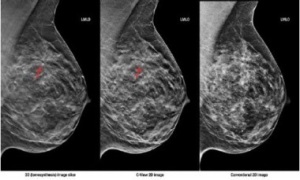by
Nancy Ryerson, Staff Writer | July 31, 2013

An image using Hologic's
tomosynthesis
The use of digital tomosynthesis in breast cancer screening may help reduce the need for additional screening and biopsy, a study published in the journal Radiology found.
The recall rate for mammography alone is about 12 percent, but fell 8.4 percent when it was used in conjunction with tomosynthesis in the study. The 3-D image tomosynthesis allows radiologists to view the breast in sequential slices, eliminating overlapped tissue from view.
"Tomosynthesis allows radiologists to feel more comfortable that there's nothing on a mammogram," said Dr. Brian Haas, a radiologist at Yale University School of Medicine, to DOTmed News.
The survey looked at 13,158 patients, 6,100 of which received tomosynthesis. In addition to reducing recall rates, with tomosynthesis, the cancer detection rate rose to 5.7 per 1,000 from 5.2 per 1,000
All age groups and breast densities had reduced risk for recall in the study, but the technology was especially beneficial for women with dense breasts. Dense breasts have more glandular tissue, which can overlap and create the appearance of possible cancer or hide cancer that is present.
Younger women also saw better results with tomosynthesis, though the researchers are not sure why. Haas said the use of tomosynthesis could impact the debate about what age women should start to be screened.
"The screening age debate has to do partly with issues of false positives," said Haas. "I think tomosynthesis will help put aside concerns on whether we should be screening young patients."
Tomosynthesis uses approximately double the dose of mammography, but Haas said new, FDA-approved
technology from Hologic provides a lower dose. He notes the administered radiation even with previous tomo technologies is still less than the maximum allowed dose, and less than non-digital mammography.
